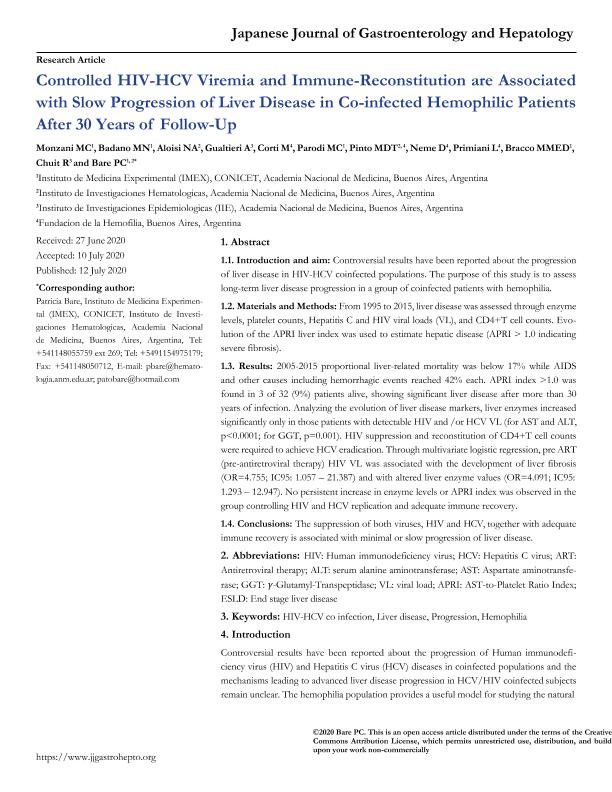Mostrar el registro sencillo del ítem
dc.contributor.author
Badano, Maria Noel

dc.contributor.author
Monzani, María Cecili
dc.contributor.author
Aloisi Zavala, Natalia Andrea

dc.contributor.author
Gualtieri, Ariel Félix

dc.contributor.author
Corti, Marcelo

dc.contributor.author
Parodi, María Cecilia

dc.contributor.author
Pinto, Tezanos
dc.contributor.author
Primiani, Laura
dc.contributor.author
Bracco, M. M. E. D.
dc.contributor.author
Chuit, Roberto
dc.contributor.author
Baré, Patricia

dc.date.available
2022-09-23T10:36:48Z
dc.date.issued
2020-07
dc.identifier.citation
Badano, Maria Noel; Monzani, María Cecili; Aloisi Zavala, Natalia Andrea; Gualtieri, Ariel Félix; Corti, Marcelo; et al.; Controlled HIV-HCV Viremia and Immune-Reconstitution are Associated with Slow Progression of Liver Disease in Co-infected Hemophilic Patients After 30 Years of Follow-Up; Japanese Journal of Gastroenterology and Hepatology; Japanese Journal of Gastroenterology and Hepatology; 7-2020; 1-7
dc.identifier.issn
2435-1210
dc.identifier.uri
http://hdl.handle.net/11336/170117
dc.description.abstract
Introduction and aim: Controversial results have been reported about the progressionof liver disease in HIV-HCV coinfected populations. The purpose of this study is to assesslong-term liver disease progression in a group of coinfected patients with hemophilia.1.2. Materials and Methods: From 1995 to 2015, liver disease was assessed through enzymelevels, platelet counts, Hepatitis C and HIV viral loads (VL), and CD4+T cell counts. Evolution of the APRI liver index was used to estimate hepatic disease (APRI > 1.0 indicatingsevere fibrosis).1.3. Results: 2005-2015 proportional liver-related mortality was below 17% while AIDSand other causes including hemorrhagic events reached 42% each. APRI index >1.0 wasfound in 3 of 32 (9%) patients alive, showing significant liver disease after more than 30years of infection. Analyzing the evolution of liver disease markers, liver enzymes increasedsignificantly only in those patients with detectable HIV and /or HCV VL (for AST and ALT,p<0.0001; for GGT, p=0.001). HIV suppression and reconstitution of CD4+T cell countswere required to achieve HCV eradication. Through multivariate logistic regression, pre ART(pre-antiretroviral therapy) HIV VL was associated with the development of liver fibrosis(OR=4.755; IC95: 1.057 21.387) and with altered liver enzyme values (OR=4.091; IC95:1.293 ? 12.947). No persistent increase in enzyme levels or APRI index was observed in thegroup controlling HIV and HCV replication and adequate immune recovery.1.4. Conclusions: The suppression of both viruses, HIV and HCV, together with adequateimmune recovery is associated with minimal or slow progression of liver disease.
dc.format
application/pdf
dc.language.iso
eng
dc.publisher
Japanese Journal of Gastroenterology and Hepatology
dc.rights
info:eu-repo/semantics/openAccess
dc.rights.uri
https://creativecommons.org/licenses/by-nc-sa/2.5/ar/
dc.subject
HIV-HCV COINFECTION
dc.subject
LIVER DISEASE PROGRESSION
dc.subject
HEMOPHILIA
dc.subject.classification
Inmunología

dc.subject.classification
Medicina Básica

dc.subject.classification
CIENCIAS MÉDICAS Y DE LA SALUD

dc.subject.classification
Virología

dc.subject.classification
Ciencias Biológicas

dc.subject.classification
CIENCIAS NATURALES Y EXACTAS

dc.title
Controlled HIV-HCV Viremia and Immune-Reconstitution are Associated with Slow Progression of Liver Disease in Co-infected Hemophilic Patients After 30 Years of Follow-Up
dc.type
info:eu-repo/semantics/article
dc.type
info:ar-repo/semantics/artículo
dc.type
info:eu-repo/semantics/publishedVersion
dc.date.updated
2021-09-07T19:13:41Z
dc.journal.pagination
1-7
dc.journal.pais
Japón

dc.description.fil
Fil: Badano, Maria Noel. Consejo Nacional de Investigaciones Científicas y Técnicas. Instituto de Medicina Experimental. Academia Nacional de Medicina de Buenos Aires. Instituto de Medicina Experimental; Argentina
dc.description.fil
Fil: Monzani, María Cecili. Academia Nacional de Medicina de Buenos Aires; Argentina. Consejo Nacional de Investigaciones Científicas y Técnicas; Argentina
dc.description.fil
Fil: Aloisi Zavala, Natalia Andrea. Academia Nacional de Medicina de Buenos Aires; Argentina
dc.description.fil
Fil: Gualtieri, Ariel Félix. Academia Nacional de Medicina de Buenos Aires; Argentina
dc.description.fil
Fil: Corti, Marcelo. Fundacion de la Hemofilia; Argentina
dc.description.fil
Fil: Parodi, María Cecilia. Consejo Nacional de Investigaciones Científicas y Técnicas. Instituto de Medicina Experimental. Academia Nacional de Medicina de Buenos Aires. Instituto de Medicina Experimental; Argentina
dc.description.fil
Fil: Pinto, Tezanos. Academia Nacional de Medicina de Buenos Aires; Argentina
dc.description.fil
Fil: Primiani, Laura. Fundacion de la Hemofilia; Argentina
dc.description.fil
Fil: Bracco, M. M. E. D.. Consejo Nacional de Investigaciones Científicas y Técnicas. Instituto de Medicina Experimental. Academia Nacional de Medicina de Buenos Aires. Instituto de Medicina Experimental; Argentina
dc.description.fil
Fil: Chuit, Roberto. Academia Nacional de Medicina de Buenos Aires. Instituto de Investigaciones Epidemiológicas; Argentina
dc.description.fil
Fil: Baré, Patricia. Consejo Nacional de Investigaciones Científicas y Técnicas. Instituto de Medicina Experimental. Academia Nacional de Medicina de Buenos Aires. Instituto de Medicina Experimental; Argentina
dc.journal.title
Japanese Journal of Gastroenterology and Hepatology
dc.relation.alternativeid
info:eu-repo/semantics/altIdentifier/url/https://jjgastrohepto.org/pdf/JJGH-v4-1370.pdf
Archivos asociados
